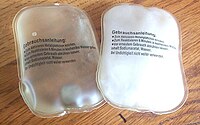
Photo from wikipedia
Abstract A systematic experimental identification approach for fired clay, the base material of bricks and clay block masonry, is essential to optimize the mechanical and thermal properties and, in this… Click to show full abstract
Abstract A systematic experimental identification approach for fired clay, the base material of bricks and clay block masonry, is essential to optimize the mechanical and thermal properties and, in this way, extending the field of application of this sustainable and high-performant building material. For this reason, a comprehensive nanoindentation campaign was performed on two clays, one of them carbonate bearing, each fired at 880 °C and 1100 °C, in extrusion direction x and normal to it. A carefully defined load function, including a short preloading step, a holding phase of 20 s, and a very fast unloading step, allowed for (i) the decomposition of plastic and viscoelastic material response, (ii) the identification of the time-dependent behaviour as well as (iii) a neat determination of elastic moduli of different material phases. A well-developed sample preparation protocol, resulting in a very low surface roughness and, thus, allowing for very small indentation forces, together with the information of scanning electron microscopy images enabled the assignment of indentation responses to single material phases. An orientation dependency of the stiffness response for the matrix of both clays fired at 880 °C was identified, which, however, disappears at a firing temperature of 1100 °C. Furthermore, the indentation results revealed that every material phase within the investigated fired clay samples, even the quartz phase, has a distinct time-dependent behaviour, which could be sufficiently captured within the second loading phase of 20 s and described very well with three different rheological models. Finally, through the analysis of representative area elements of eight different fired clay samples, comprehensive 2D information about the elastic as well as viscous behaviour is given within this work, representing a basis and input for the development of micromechanical models for fired clay material.
Journal Title: Construction and Building Materials
Year Published: 2020
Link to full text (if available)
Share on Social Media: Sign Up to like & get
recommendations!